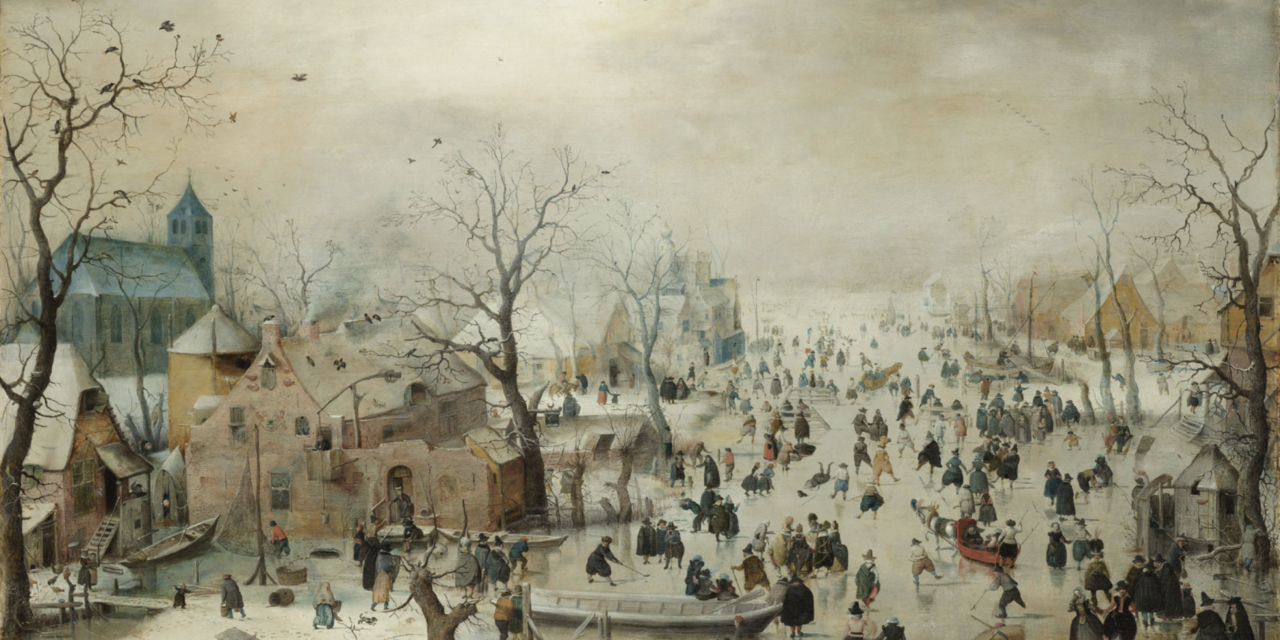The Little Ice Age and the Downfall of Ming Dynasty China
The climate has always had a profound impact on human societies, and the Ming Dynasty’s decline is no exception. In the case of 17th-century China, environmental changes were among the critical factors that contributed to the end of one of the greatest dynasties in Chinese history.
The Little Ice Age and Its Timing Although the Little Ice Age (LIA) is often dated from around 1580, based on European historical data, evidence from Asia suggests that it began as early as the 14th century. China, however, experienced an especially cold period from 1640 to 1660, which intensified the hardship of the population and amplified existing pressures on the Ming Dynasty’s rule.
Climate, Crops, and Crisis During this unusually cold phase, crops failed on a massive scale, triggering widespread starvation. People were pushed to the brink, and epidemic diseases began to spread rapidly. These successive disasters led to a population decline of around 11% over just 20 years, weakening the societal and economic fabric of the Ming Dynasty, which had ruled China since 1368. This combination of environmental and social stresses was one of the catalysts that led to the dynasty’s ultimate downfall in 1644.
The Evidence of Collapse Historian Timothy Brook provides a window into the impacts of the Little Ice Age in his book The Price of Collapse. He draws extensively on the writings of Chen Qide, a local schoolteacher from the Yangzi Delta, who was born into a minor gentry family. In his essays written in 1641 and 1642, Chen vividly describes the conditions of the time: food prices skyrocketed, supplies dwindled, and people faced starvation on an unprecedented scale. Brook supports these accounts with contemporary economic data, demonstrating how climate-induced agricultural failures translated into economic crisis, visible in records of soaring food prices.
Systemic Problems within the Ming Great State Yet, the environmental pressures of the Little Ice Age did not act alone. From around 1550 onwards, the Ming Great State was already grappling with significant internal challenges: economic problems, corruption, weak leadership, and a series of peasant uprisings. At the same time, external threats loomed at its borders. To the north, the Manchus, originally known as the Jurchens, had reorganized themselves under strong leadership, building a cohesive military and administrative structure.
The Invasion and the Fall of the Ming In the face of a weakened Ming state, the Manchus launched their invasion, exploiting both the Ming Dynasty’s internal instability and the Little Ice Age’s devastating effects on food supply and population health. By the time the Manchus entered China, much of the resistance had been worn down by decades of hardship, clearing the path for them to establish the Qing Dynasty in 1644.
The Role of Silver
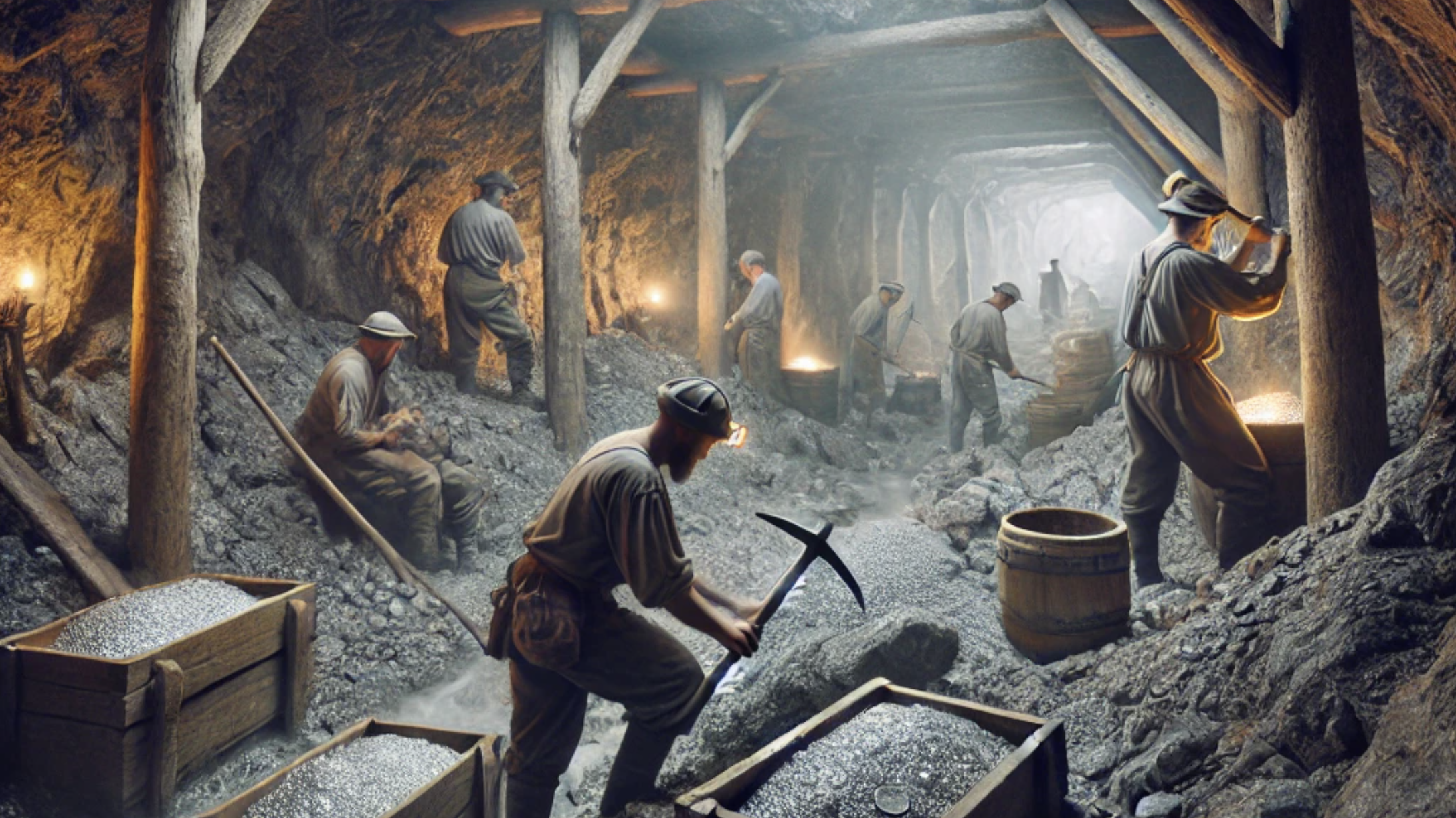
The Role of Silver in Ming China’s Downfall
In 16th-century China, the demand for silver became a crucial factor in both its economic landscape and the hardships experienced by its lower classes, setting the stage for profound social changes.
China’s “Silver Tax” and the Shift to a Single Whip System Prior to the 1580s, the Ming Dynasty allowed taxes to be paid in multiple forms: goods, services-in-kind, copper ‘cash’, or silver. However, in a major reform known as the “Single Whip System,” the Ming government mandated that all taxes be paid exclusively in silver. This reform had two major consequences. First, it created an unprecedented demand for silver within China. Second, it intensified the financial burden on peasants and lower classes, who now had to procure silver, often at great personal cost, to meet their tax obligations.
An Unfortunate Global Surge in Demand This move to a silver-based tax system happened just as global demand for certain luxury commodities was rising, further exacerbating the demand for silver. New stimulating drinks like coffee, tea, and cocoa were becoming increasingly popular, and sugar was needed to sweeten them. Afterward, people often smoked tobacco, creating a pattern of interconnected consumption. As these products became staples of elite society, the desire for a reliable and widely accepted currency for trade grew.
Silver as a Global Medium of Exchange Silver quickly became the preferred medium of exchange in this burgeoning global trade. European merchants, eager to capitalize on Asia’s demand for silver, began using it to purchase local products in Asian markets. Chinese sellers, influenced by the silver tax, readily accepted it as payment. This created a massive flow of silver from Europe to Asia, which fuelled European powers’ expansion of silver production, notably in mines like Potosí in Bolivia. Over time, the balance of economic power began to shift toward Europe, which controlled these rich silver resources and used them to sustain a profitable trade in valuable commodities like tea, silk, and spices.
The Darker Side of Silver: Slavery and Forced Labour The historical introduction of silver as a currency in places like ancient Athens and early China is often celebrated as a milestone in economic development. However, the darker reality is that silver mining was frequently associated with inhumane labour practices. Since the early days of Athenian coinage, slaves or forced labourers were made to work under harsh conditions to extract silver, which was viewed as ‘dirty work.’ With the imposition of the Chinese silver tax, these oppressive practices took on a new dimension, as the increased demand for silver led to intensified hardship for China’s lower classes, who struggled to meet their tax obligations in silver.
The Horrors of Potosí: “The Mountain that Eats Men” A significant portion of the silver flowing into China and other parts of Asia came from Potosí, in present-day Bolivia, also known as “The Mountain that Eats Men.” Under the Spanish colonial system, Potosí was part of the Viceroyalty of New Spain, and its silver production helped finance Spain’s global ambitions. By the mid-1600s, Potosí alone produced 60% of the world’s silver. However, this came at a tremendous human cost. The Spanish enforced a brutal labour system known as the ‘Mita,’ which required indigenous people to work in appalling conditions, leading to high mortality rates. Many labourers perished in the hazardous depths of the mines, trapped in a cycle of exploitation that cast a long shadow over silver’s legacy.
Europeans in the “New World”
The Demand for Labour As European powers explored and colonized the Americas, they encountered rich resources and fertile lands that offered lucrative opportunities, especially through the cultivation of cash crops like tobacco and sugar. These crops, however, required intensive labour, which would drive profound social and economic changes on both sides of the Atlantic.
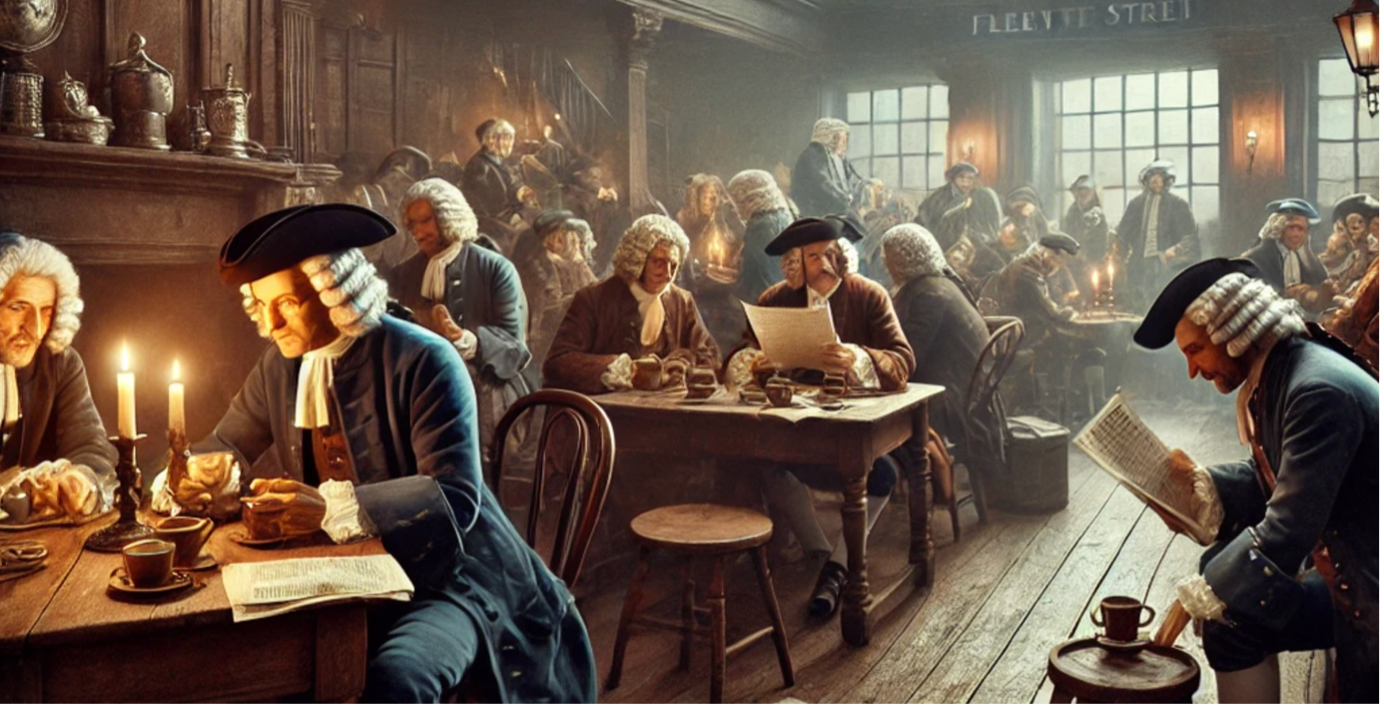
The Tobacco and Sugar Boom The “New World” opened vast agricultural possibilities. In the Chesapeake region, European settlers capitalized on the popularity of tobacco, which quickly became a booming industry, fuelling trade across the Atlantic. Similarly, in the Caribbean, sugar plantations emerged as another cornerstone of colonial economies. However, both tobacco and sugar cultivation were labour-intensive, demanding a steady and substantial workforce.
Initially, European colonies relied on indentured servants—labourers who worked for a set period in exchange for passage to the Americas. However, as demand for labour grew and indentured servants became less readily available, plantation owners increasingly turned to enslaved Africans. This shift led to the rapid expansion of the Atlantic slave trade and a growing dependence on slave labour as a fundamental component of the colonial economy.
Changing Consumer Habits in Europe During the same period, new consumer habits emerged in Europe that further fuelled the demand for products from the Americas. Coffee, tea, and cocoa became popular beverages, each carrying its own appeal and requiring a steady supply of sugar for sweetening. Coffee houses began to spring up, especially in England and the Netherlands, creating social hubs where patrons enjoyed imported coffee and tea.
European demand for tea, especially from China, led to fierce competition among colonial powers, with each vying to secure trade routes and access to this prized commodity. Cocoa, combined with sugar from American plantations, became a delicacy in European courts. Together, these new consumer habits intensified the need for plantation labour to produce the raw materials. The connection between these luxuries and the labour required to produce them meant that colonies, particularly in the Caribbean, relied heavily on enslaved Africans to meet demand.
The Sugar Trade from the Caribbean European colonial powers soon realized that sugar, in particular, held enormous economic potential. The Caribbean became the centre of a vast sugar industry, with plantations spread across various islands. Sugar production and trade routes flourished, with strategically located ports such as Havana and Portobello facilitating the movement of goods and enslaved people. Commodities from the Caribbean fuelled the global trade network, and sugar’s profitability attracted investment and competition among colonial powers.
The process of cultivating and refining sugar, however, took a heavy toll on both the indigenous people and the enslaved Africans forced to work under brutal conditions. Mesoamerican traditions and knowledge about sugar processing played a role, but European expansion transformed sugar into a key commodity in the global market. The sugar industry would not have been possible without the widespread use of enslaved labour, establishing an economic system dependent on exploitation and enforced servitude.
The Atlantic Slave Trade
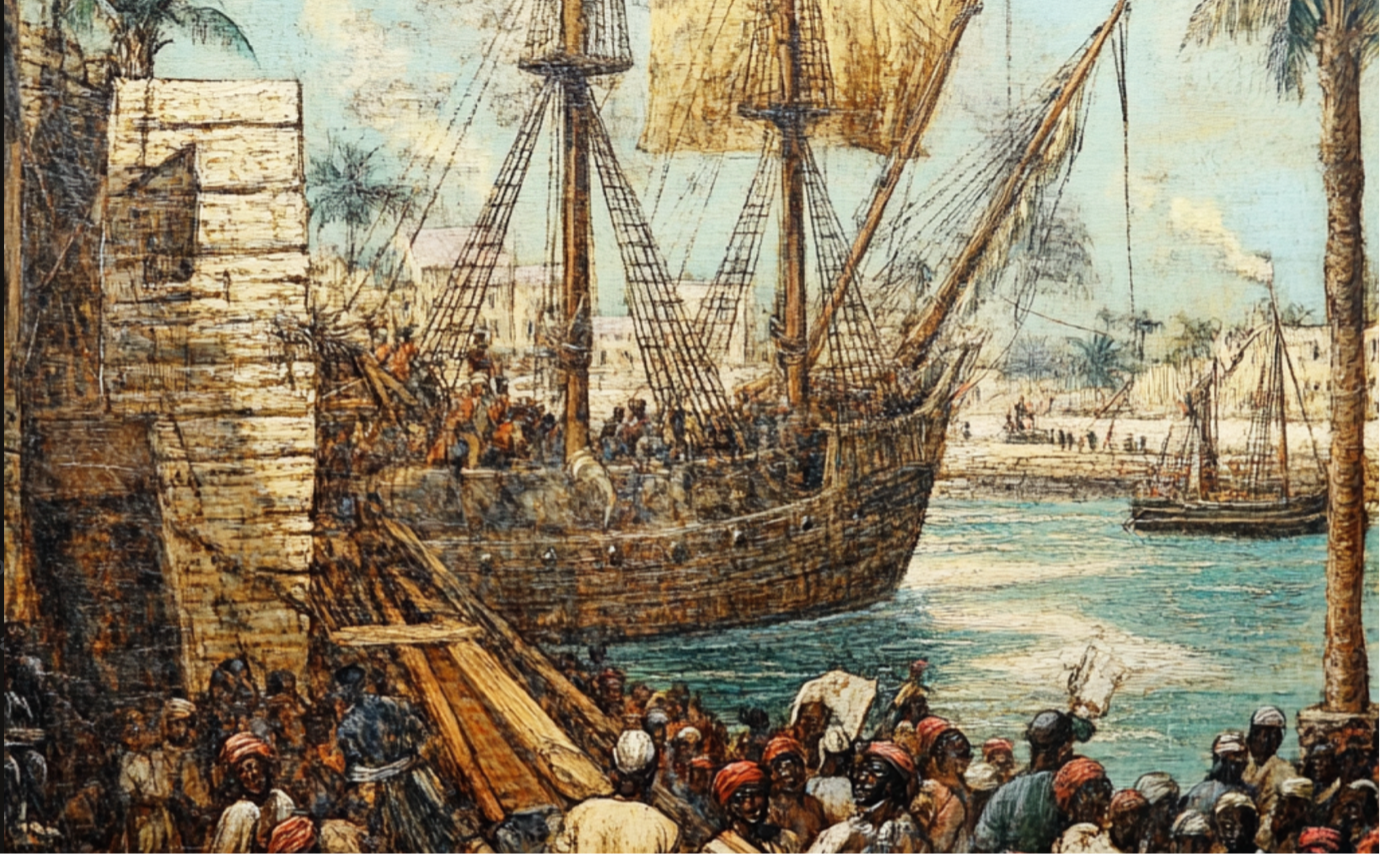
As the demand for labour in the Americas grew, European powers turned increasingly to Africa as a source of enslaved labour, leading to the emergence of the Atlantic slave trade—a system that would profoundly shape the economies, societies, and human landscapes on both sides of the Atlantic.
Supplying the Demand for Labor. The Atlantic slave trade grew into a massive, transcontinental network, ultimately transporting an estimated 12.5 million Africans across the ocean to the Americas. Key departure points for enslaved Africans were located along the western coast of Africa, particularly in areas where European powers had established trading posts. The main destinations for these captives were the plantations and mines of the Caribbean, Brazil, and the southern United States, where they were forced into gruelling labour under inhumane conditions. The trade became an economic engine of the Atlantic world, fuelling profits for European traders and plantation owners but exacting an appalling human cost on the captives and their descendants.
Complex African Participation in the Trade While the brutal transatlantic slave trade was driven primarily by European demand, certain African kingdoms and leaders were involved in various ways. Some African leaders resisted European encroachment and the pressures of the trade. Queen Nzinga of Ndongo, for example, is remembered for her diplomatic and military resistance to Portuguese influence in what is now Angola. Despite such resistance, some African kingdoms participated in the trade, engaging with European powers in complex, often coerced relationships. Kingdoms like Ndongo and Matamba were affected by the slave trade’s economic allure as well as by the need to navigate the realities of European power.
Direct Capture and Raiding Not all African captives were traded by African intermediaries. Portuguese raiding parties, especially in the early years of the trade, conducted direct coastal raids and incursions further inland, capturing individuals to meet the demands of European colonies. These violent encounters destabilized African communities, triggering cycles of violence, militarization, and social upheaval as people were captured and transported en masse to the coast. In some regions, the pressure to capture and trade captives led to an increase in local conflicts and significantly altered African political dynamics.
The Horrors of the Slave Trade The journey from capture to enslavement in the Americas was a brutal and dehumanizing ordeal. Captives were often forced to endure long marches to the coast, bound together, and kept in deplorable conditions in holding pens known as “slave forts.” From there, they faced the horrors of the Middle Passage, the transatlantic voyage that packed enslaved Africans into ships under horrific conditions. Subjected to overcrowding, malnutrition, disease, and abuse, many did not survive the journey. Those who reached the Americas faced lives of brutal labour, dehumanization, and constant trauma. Life expectancy for enslaved people was tragically low, as plantation work in sugar, tobacco, and other industries wore them down physically and psychologically, often leading to premature death.
The Birth of Modern Capitalism?
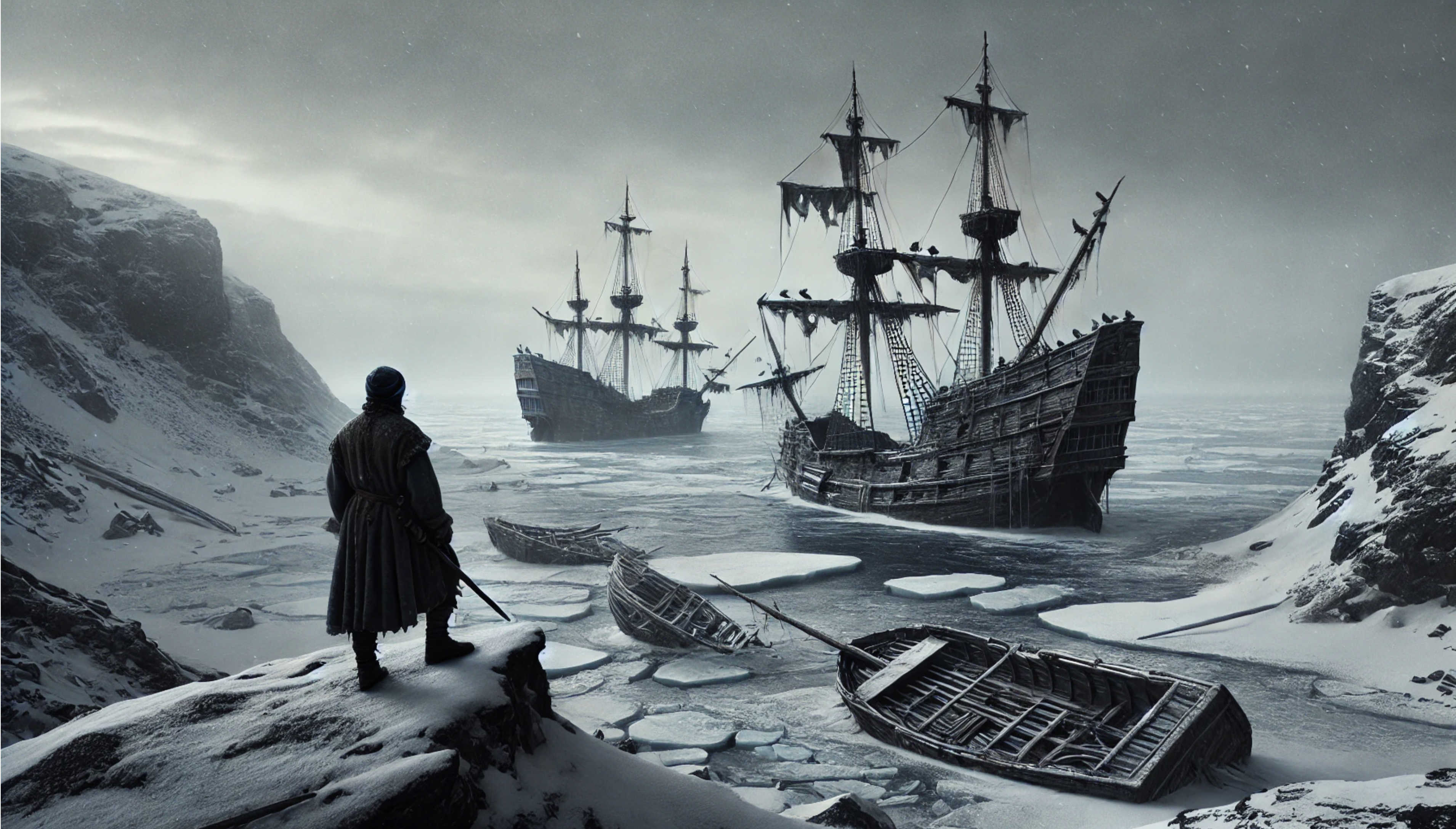
In the 16th and 17th centuries, European powers, eager to establish direct access to the lucrative Spice Islands in the South China Sea, sought alternative routes to avoid the dominance of Portuguese and Spanish-controlled waters. This intense competition led explorers to venture into the Arctic, hoping to find a Northern route to Asia—a venture that would eventually contribute to the development of modern capitalism.
A Northern Route to the Spice Islands? As Britain and the Netherlands grew frustrated with the traditional routes controlled by Spain and Portugal, they turned their attention northward, hoping to find a passage over the top of Russia (the Northeast Passage) or across North America (the Northwest Passage). These Arctic expeditions, however, proved perilous and ultimately unsuccessful, as explorers faced unforgiving conditions and often perished in the frozen wilderness. The allure of spices—valuable for preserving food and enhancing flavour—was a powerful motivator, but the Arctic ultimately proved a dead end for these ambitions, with frozen bodies and ships preserved in the ice as eerie testaments to the failed attempts.
Richard Chancellor and Ivan the Terrible One Arctic expedition, however, led to an unexpected opportunity for England. In the 1550s, English navigator Richard Chancellor found himself diverted from his intended course and arrived instead in Russia. There, he met Tsar Ivan the Terrible, who saw an opportunity to strengthen his economy through trade with Western Europe. Chancellor was warmly received at Ivan’s court, where he witnessed the opulence and power of Russian royalty. This meeting led to the foundation of the Muscovy Company, one of the earliest English trading companies, marking a pivotal moment in Anglo-Russian relations. The Muscovy Company established trade links that bypassed the spice trade but opened new economic avenues, setting a precedent for future ventures.
The Rise of Joint Stock Companies The formation of the Muscovy Company also demonstrated a new way of organizing business ventures that would prove transformative: the joint stock company. Unlike traditional ventures, joint stock companies allowed investors to pool their resources and spread the financial risk, making it feasible to fund large and potentially risky expeditions. Shareholders could purchase shares, and in return, they were entitled to a portion of the profits in the form of dividends. Additionally, the concept of limited liability meant that investors were protected from losing more than their initial investment, a significant innovation that encouraged broader participation in such ventures.
The Muscovy Company became an early example of this model, and the success of joint stock companies spurred the formation of similar organizations with monopoly rights granted by their governments. This structure allowed for larger and more ambitious undertakings, including ventures to the East Indies and later the Americas, where joint stock companies like the Dutch East India Company and the English East India Company played a dominant role. These companies became powerful entities in their own right, not only fostering trade but also establishing political and military influence in the regions they operated. The joint stock company model laid the foundations for modern capitalism by creating an interconnected network of capital, risk-sharing, and profit-seeking that fuelled European expansion and economic growth.
Trade Wars and Britain’s Growing Empire in the Americas
The establishment of the British Empire and its influence across the globe was fueled by the growth of trading companies, intense rivalry with other European powers, and strategic territorial decisions. The East India Company, along with rivalries in the spice trade and territorial exchanges, played a significant role in shaping the foundations of Britain’s growing empire.

The East India Company: A Commercial and Political Entity Founded in 1600 under a royal charter from Queen Elizabeth I, the East India Company was more than a commercial enterprise; it was a powerful political entity with the mandate to represent British interests in Asia. The company held monopoly power over English trade in the East Indies, but its influence went beyond commerce. It was empowered to wage war, negotiate treaties, and establish fortified posts to protect its trade routes and outposts. Organized as a joint-stock company, the East India Company allowed shareholders to invest in its ventures, receiving dividends from its profits. Over time, it became a central player in global trade, significantly impacting both Britain’s economy and its foreign policy.
The Strategic Island of Run One of the East India Company’s earliest strategic moves was to break the Dutch monopoly on the lucrative spice trade. The small, remote Island of Run in the Banda Islands became a focal point in this struggle due to its valuable nutmeg crop, which was highly sought after in Europe. In 1616, English captain Nathaniel Courthope landed on Run, establishing a foothold for England in the spice trade. This foothold allowed the English to challenge the Dutch East India Company’s (VOC) monopoly in the region, though it came at a high cost due to the intense competition and conflict with the Dutch.
Intense Rivalry and the VOC Founded in 1602, the VOC was a formidable rival to the English East India Company, with extensive military and naval resources that allowed it to dominate the spice trade. The Dutch fortified their trading posts and maintained exclusive control over key spice-producing regions. With superior naval power and a stronger military presence, the VOC resisted English attempts to break into its monopoly, leading to a bitter struggle over access to the spice trade. The English and Dutch repeatedly clashed, each fortifying their posts to secure strategic trade routes, which eventually led to open conflict.
A Fair Swap? The Treaty of Breda This intense Anglo-Dutch rivalry culminated in the Treaty of Breda in 1667, which concluded the Second Anglo-Dutch War. Under the terms of the treaty, England ceded its claims on the Island of Run to the Netherlands, while the Dutch, in turn, relinquished control of the colony of New Amsterdam in North America. New Amsterdam, located on the island of Manhattan, was subsequently renamed New York by the English. Although Run held great short-term value for its nutmeg production, the long-term significance of Manhattan proved far greater. The Treaty of Breda marked a strategic shift in priorities, as England increasingly focused on territorial expansion in the Americas.
Britain’s Growing Empire in the Americas With the conclusion of the Treaty of Breda and subsequent wars, Britain steadily expanded its influence and territorial control in North America. This expansion was consolidated after the Seven Years’ War, which solidified British dominance over significant parts of North America. The trade-driven focus of earlier territorial exchanges gave way to a broader vision of empire, with Britain’s colonies in America growing in size and importance. These territorial shifts set the stage for Britain’s emergence as a global power, with a lasting legacy that would shape the economic and political landscape of the Americas.
Conclusion
During the seventeenth and eighteenth centuries, the pursuit of wealth and power through global trade drove European empires to seek direct access to lucrative goods like spices, sugar, and tobacco, reshaping economies and societies across continents. In Ming China, the introduction of a silver tax intensified demand for silver with severe social consequences, while in the Americas, labour-intensive crops spurred the brutal reliance on enslaved Africans. As European powers like the Dutch and English East India Companies clashed over trade monopolies, joint stock companies emerged, allowing broader public investment and profit-sharing. This new economic structure, alongside the crown’s reliance on commercial success, laid the groundwork for modern capitalism and its enduring global influence.
Terry Cooke-Davies
2nd November 2024
Profound thanks to ChatGPT(4o) from OpenAI for assistance with this article.

